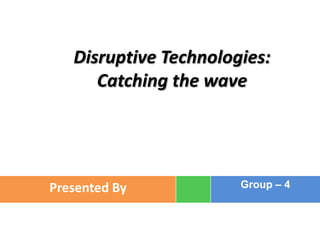
Disruptive technlogy
- 1. Disruptive Technologies: Catching the wave Presented By Group – 4
- 2. Refreshment What is Disruptive Technology? ”The processes and incentives that companies use to keep focused on their main customers work so well that they blind those companies to important new technoloAny new technology that is: - significantly cheaper than current, and/or - is much higher performing, and/or - has greater functionality, and/or - is more convenient to use Revolutionary, not Evolutionary Used to be called “Killer Apps”gies in emerging markets.”
- 3. Examples of Disruptive Technology Past Future Electricity Combustion Engine Nanotechnology Telephones Web Services Computers Collaboration Software Airplanes Cloud computing Plastic Birth Control Pills Internet
- 4. Difference Disruptive Sustaining 1. New entrants 2. Not customer driven 1. Current industry leaders 3. Not market driven 2. Listen to their customers 4. Radical change 3. Incremental change 5. Short sales cycle 4. Financial infrastructure 6. Smaller profit 5. Long sales cycle 7. Upset industry Vs 6. Fear of cannibalism hierarchy 7. Aristocratic 8. Wide impact 9. Democratic Examples: Examples: 3.5” hard disk dive- Corner 5.25” hard disk dive- Seagate Mini computers Mainframe computers- IBM Table top small copier – Cannon Large photocopier - Xerox
- 5. Dilemma The Innovator’s Dilemma - It performs worse in one or more areas, but is typically simpler, more reliable, or more convenient than existing technologies. - Its performance trajectory is steeper than that of existing technologies. - It is less profitable than existing technologies. - Leading firms' most profitable customers generally can't use it and don't want it. - It is first commercialized in emerging or insignificant markets. - Large organizations are fundamentally incapable of successfully bringing it to market.
- 6. B&C argue Technologies that damage established companies are not radically new or complex, but: 1) They present a different package of performance attributes that are nor valued by existing customers. 2) The performance attributes that are not valued, improve at such a rapid rate the new technology can later invade the established markets.
- 7. Performance Trajectories The rate at which the performance of a product has improved and is expected to improve in the future. S - Curves (product performance - vertical axis & time/effort - horizontal axis). Every industry has a critical performance trajectory (e.g. Photocopiers - no. of copies per minute).
- 8. Bower and Christensen put forward a two-pronged approach to dealing with disruptive technologies. Approach -1 Senior executives must be able to spot new technologies that fall into this category : – i.e., ’different’ packages of performance attributes able to evolve rapidly to the point where they can successfully invade established markets. Approach -2 For these new technologies to be commercialized and established, they must be protected from processes and incentives geared to serving established customers – i.e., housed by organizations that are completely independent from the mainstream business.
- 9. It is not enough to identify and track a new technology. Management should also: Determine whether the technology is disruptive or sustaining. Who supports it and who doesn’t? (Conflict of marketing and finance vs. key technical staff often indicates a disruptive technology that should be explored). Identify its strategic significance. Ask the right questions (about functionality & demand) to the right people – not current lead customers Locate initial markets for the disruptive technology. Instead of market research, information on new markets should be generated through rapid, iterative, and low-cost experimentation with both products and markets.
- 10. Placing responsibility for building a disruptive technology business in an independent organization (or ’skunk works’) should be done for the right reasons. For example, one should not isolate a team of engineers in order to develop a sustaining technology, even though it may be a radically different one. Creating a separate organization is only necessary when: • The disruptive technology has a lower profit margin than the mainstream business, and • Serves the unique needs of a new set of customers. Locate initial aWhere these conditions are met, though, the disruptive organization should be kept independent. Folding a commercially viable markets for the disruptive technology. Folding a commercially viable disruptive spin-off back into the mainstream organization can be diasastrous.
- 11. Bower and Christensen state their strategic advice on ’prospering at points of disruptive change’ as follows: The key principle is not simply to Take more risks, Invest for the long term Fight bureaucracy Rather, success depends on managing strategically important disruptive technologies in an organizational context where Small orders create energy Fast, low-cost forays into ill defined markets are possible, and Overhead is low enough to permit profit, even in emerging markets
- 12. Thank You
Notas del editor
- Understanding customers need
- Understanding customers need
- Understanding customers need
